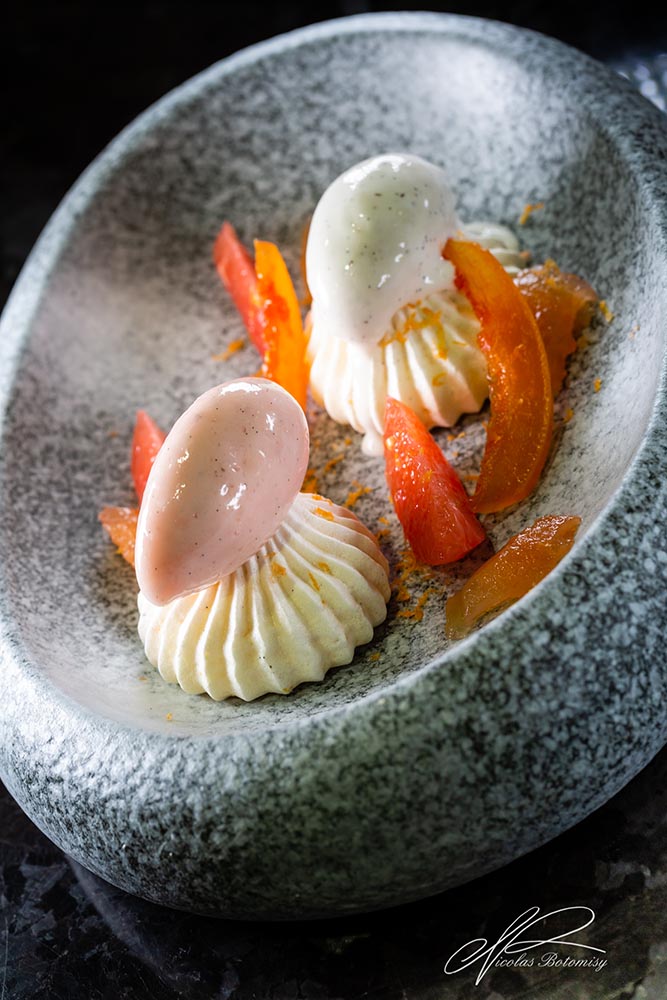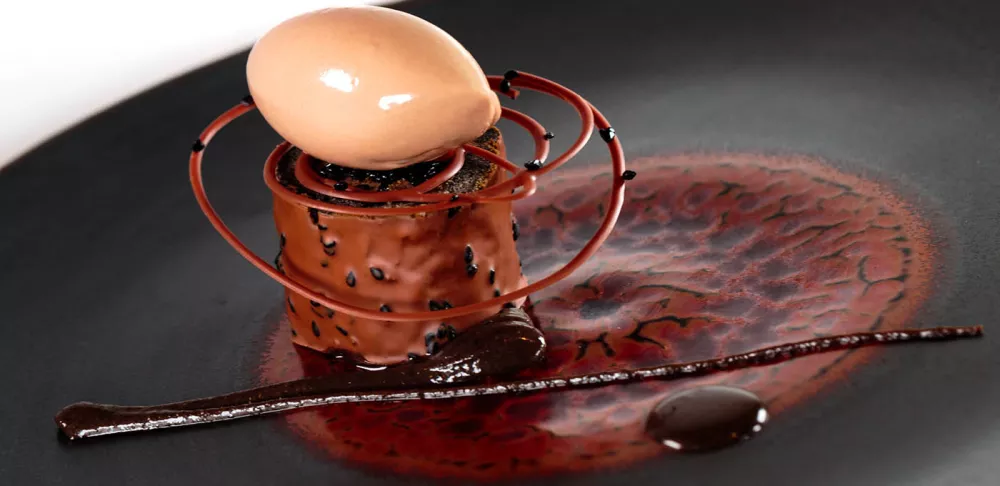In the Center for Advanced Pastry Studies’ (CAPS) March class, Pastry Chef Nicolas Botomisy will share his experience from Michelin-starred restaurants and luxury hotels in France, the U.K., Japan and the U.S.
A veteran of Valrhona schools in Tokyo and Brooklyn, Nicolas specializes in chocolate. He’ll share his techniques for developing desserts and approach to formulating taste in this two-day plated desserts course.
Here, we get to know the visiting instructor in advance with a few questions about his background, businesses and plans for the class.
How does pastry work in luxury hotels compare to your restaurant experience?
In the hotels, you have to bring a luxury experience from start to the end. Of course, this includes the pastry part. Everything has to be fresh, made as close as possible to the tasting time. Looking good is important, but tasting amazing and making you want to have another one is more important. Pastry chefs are able to work with the best available ingredients on the market when cost is not a problem.
What are the most valuable lessons you learned in the prominent restaurants that you worked in?
The most important is what you get on the plate! Taste and texture are everything. If you have a good-quality ingredient, it is really easy to have a good result as you have to emphasize the star, which is the ingredient! That being said, you have to have a good technique in order to achieve the result you have in mind.

How important is plating in pastry and what does it require from a chef?
Plating is the last step of all the hard work you put in prior to service. It is one of the most important steps as the client gets their first impression from the appearance. Sometimes you can even order a dessert because the guest next to you had something appealing. It requires the pastry chef to be efficient, precise, concentrated and able to follow the process decided during the conception of the dessert. Repeating the same operations is a skill that could be compared to a racing driver who is able to put his wheel at the same spot every single lap.
How would you describe your ateliers?
Places where I share knowledge, passion, know how and emotion through desserts and taste. For that main purpose, sharing, I don’t like to be called chef, as it is impossible to be in the sharing mood with a military ranking. The training is an occasion for us to come together and for everyone to contribute. I like exchanges in which everyone adds something.
Are there certain flavors or trends more prevalent in Paris or Tokyo than in New York?
I travel worldwide for consulting, demonstration and classes, and I am always amazed to discover new ingredients or techniques. All over the world pastry chefs have the same passion, and regardless of language, background or culture, we all share something in common: love for good pastry and love for serving good food to others.
I am French and I used to live in Tokyo (where I now go every month to set up a business) and I live in New Jersey. Of course, in my desserts I use some French technique, Japanese technique, American taste and Japanese ingredients with the French background. I like the liberty of American gastronomy, the technicality and dedication of the Japanese craftsman, and the basic techniques and tastes of France. I mix everything.
What ingredient or technique are you most excited about right now?
I love to play with ingredients and textures. For me, the technique is just a way to achieve what we want the same as we use letters and words to make sentences and express ideas. I like seasonal ingredients and fruits like chestnut, apple, pears... and work on how to bring out my gourmand spirit on a plate and make the dish even more enjoyable without adding more sugar. Most of my pastry is already gluten-free for the purpose of being light, and now I’ve started to care even more about low sugary content.
What does it mean to incorporate feelings and emotions into taste?
It’s just that you will go beyond technique. A technical dessert is good but it misses something. We need technique to express our ideas the same way a musician needs to know the scale and the relative minor and major, but if you don’t add something more, you won’t have that little extra, that emotion and feeling. To go on with the comparison with music, the recipe is the music sheet and depending how you play it ⎯ the dynamic, the emotions ⎯ you will have a totally different music piece.
Where was the most beautiful plated dessert you’ve seen recently?
Now with social media and Instagram, we see many nice things! But the most important thing is the taste and the experience. Many places in the world offer such good things. I was lucky to have a great experience a few months ago at the Four Seasons Hotel George V in Paris: nice tastes and textures and stunning presentation.
Who should take your class and why?
Anyone who wants to have fun and learn! It will be good for the pastry chef beginner who wants to step up and discover new techniques and trends or the qualified one who wants to tune their expertise or discover new things.
What can participants expect?
The beauty of our job is endless learning for everyone. This is for the mood of the class. Practically, we will make about 10 plated desserts, creating all the various components together with different tastes and textures. It will be hands-on and I will demonstrate but let the students experience and plate the desserts by themselves. Our work is manual and it’s important to remember with your hands!
The work will be split between the students, and the group will frequently gather while I explain a specific technique. I believe the number of techniques is limited while the tastes are endless! Among others, the techniques explained, developed and practiced will include mousse, creamy texture, whipped ganache, crunchy, sauce, ice cream, sherbet, chocolate decoration, glazing and dipping technique, and decoration, as well as how to think about the mise en place, how to create your own dessert and the role of textures in the taste perception. For the plating part, I will demonstrate one dish and let the students plate their own following my advice. Then the best part: tasting. Due to the really short shelf life of all the desserts, it would be really difficult to make a buffet.
Register for Plated Desserts with Chef Nicolas and see more upcoming CAPS classes.




